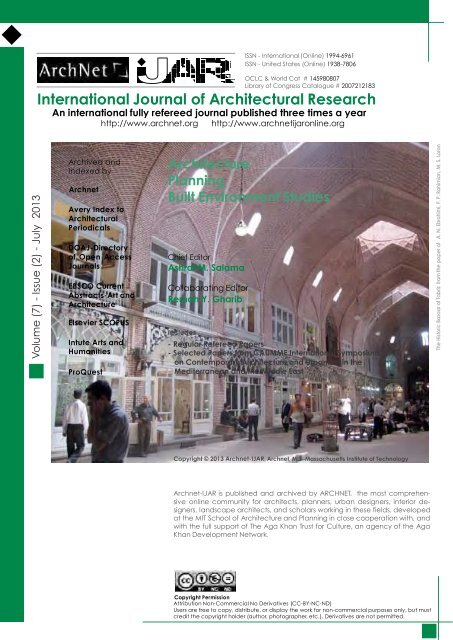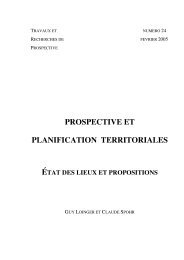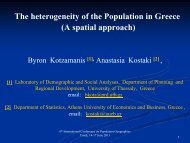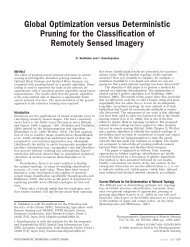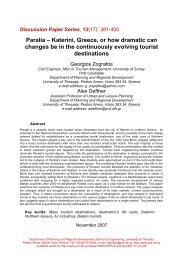International Journal of Architectural Research
International Journal of Architectural Research
International Journal of Architectural Research
Create successful ePaper yourself
Turn your PDF publications into a flip-book with our unique Google optimized e-Paper software.
<strong>International</strong> <strong>Journal</strong> <strong>of</strong> <strong>Architectural</strong> <strong>Research</strong>Pantoleon Skayannisregulations and land use permissions related to urban design at the level <strong>of</strong> neighborhood(Burkhalter and Castells, 2009).Marcuse (2010), in doubt <strong>of</strong> the capacity <strong>of</strong> planning to combat the crisis, argues for aseries <strong>of</strong> mitigation measures focusing on the protection <strong>of</strong> the most vulnerable parts <strong>of</strong> thepopulation and on the intervention <strong>of</strong> planners through their connection and influence upon thedecision making centers rather than through their plans as such. He maintains that “whileplanners are neither significantly responsible for the present economic crisis nor have the powerto affect it significantly, they do have some influence on it, and more than they are nowexercising” [p.9] (Marcuse, 2010).Under such a problematic is that the crisis <strong>of</strong> Athens, especially <strong>of</strong> the Centre isdiscussed. The international economic crisis has hit Greece and Athens most. The city is affectedby the immense national economic problems (budget deficits and fiscal crisis) accentuated by theGreek particularities (lack <strong>of</strong> transparency, corruption, tax evasion, etc.). If local, spatial andsocial, parameters are added such as high density in the Centre and urban sprawl to a largeextent based on unauthorized construction, or high concentration <strong>of</strong> poor immigrants in theCentre, all resulting in impoverishment, social exclusion, endangered social cohesion, decline <strong>of</strong>economic activity, redundancies, closures, etc., the situation becomes precarious and the impacton the built environment severe.From the point <strong>of</strong> view <strong>of</strong> planning, the efforts to plan the city in the spatial context <strong>of</strong> itswider area have been going on for many years, yet today are more necessary than ever. Thequestion is what sort <strong>of</strong> planning is mostly required under today’s circumstances and to whatextend can it have a positive impact on the city. In order to answer such questions, one wouldhave to see as part <strong>of</strong> today’s problematic the historical background both <strong>of</strong> planning and thediscussions on it, and <strong>of</strong> the several contradicting forces related to it.Thus, this paper goes through the history <strong>of</strong> the master planning <strong>of</strong> the city identifyingseveral periods by and large on the basis <strong>of</strong> drafted or tacit plans a) from the establishment <strong>of</strong> thecity as the capital <strong>of</strong> Greece (1834) until 1985 when the first somehow comprehensive masterplan was adopted, b) the next period from 1985 to to the Olympic Games (2004), c) from theOlympic Games to the current crisis (2010), d) in the context <strong>of</strong> crisis the new Regulatory MasterPlan <strong>of</strong> Athens-Attiki 2021, and finally e) amidst the crisis the staging <strong>of</strong> a series <strong>of</strong> proposals forintervention to the city center.A BRIEF OVERVIEW OF THE MILESTONES OF THE ATHENS (MASTER) PLANSUNTIL 1985Since Greece’s independence (1830), numerous attempts have been made to draft andimplement spatial plans for the city and the wider area <strong>of</strong> Athens. Yet, plans were only partiallyimplemented with delays and usually after various degrees <strong>of</strong> confrontation.The first plan was carried out by St. Kleanthes and E. Schaubert as early as 1833 (fig.1).Due to reactions raised by land owners, and to economic hardship it was not possible toimplement this plan. Instead an amendment elaborated in 1834 by Leo von Klenze was realized(fig.2) (Biris K., 1966, ed 1999: 26-39 Travlos, 1993). Since then, there have been numerousattempts to make plans for the city though mostly targeting specific sites such as opening <strong>of</strong>roads and planning <strong>of</strong> squares. Biris K. (1966) and Philippidis (1984) mention dozens <strong>of</strong> plansand proposals in the first half <strong>of</strong> the 20th century. The population <strong>of</strong> the city increased by 245,000(+52%) in 1922, after the influx <strong>of</strong> about 1.2 million refugees in the country and a populationexchange with Turkey that followed the defeat <strong>of</strong> the Greek army by Turkey in Minor Asia.Despite the obvious pressing needs and the numerous plans proposed during the course <strong>of</strong> thefirst half <strong>of</strong> the 20th century, the lack <strong>of</strong> funds and occasionally the resistance <strong>of</strong> private interestshave resulted only into a series <strong>of</strong> limited changes in the city (cf. Sarigiannis, 2012). As stated inSkayannis and Kanarelis (2012) for the first half <strong>of</strong> the 20th century, there was a little and lateefficacy <strong>of</strong> interventions, while some sort <strong>of</strong> competition between the Ministry <strong>of</strong> Communications(the Town Planning Office being subject to it) and the Municipality <strong>of</strong> Athens. WW2 found the cityArchnet-IJAR, Volume 7 - Issue 2 - July 2013 - (192-205) – Selected Papers193Copyright © 2013 Archnet-IJAR, <strong>International</strong> <strong>Journal</strong> <strong>of</strong> <strong>Architectural</strong> <strong>Research</strong>
<strong>International</strong> <strong>Journal</strong> <strong>of</strong> <strong>Architectural</strong> <strong>Research</strong>Pantoleon Skayannisalready amidst a series <strong>of</strong> problems such as the giving up <strong>of</strong> various public spaces and with nomajor city plan under implementation.Figure 1: The Plan <strong>of</strong> St. Kleanthes and E.Schaubert (1833) (Source: Johannes andBiris, ed., 2009)Figure 2: The Plan <strong>of</strong> Leo von Klenze (1834)Source: Johannes and Biris, ed., 2009).Skayannis and Kanarelis (2012) argue that the period immediately after WW2 was a periodrehabilitation and <strong>of</strong> reconstruction <strong>of</strong> the heavily damaged building stock. Yet, it was also a lostopportunity for the planning and redesign <strong>of</strong> Athens. In this context, several grand ideas wereproposed the most significant being those <strong>of</strong> K.Biris (fig. 3) and K.Doxiadis (fig.4). The firstincluded the construction <strong>of</strong> a new city (Megaris) at the west <strong>of</strong> Athens, and the secondintroduced the concept <strong>of</strong> Ecumenopolis proposing the broadening <strong>of</strong> the city and the creation <strong>of</strong>a continuum with the neighbouring cities <strong>of</strong> Halkis and Corinth. Yet, none <strong>of</strong> these wasimplemented. Instead, a timid town planning practice and the choice <strong>of</strong> cheap and quick solutionsimmediately after the war became dominant and no important interventions in public space or thecreation <strong>of</strong> new spaces such as squares were achieved. Still, the main concern, as the private carwas taking the lead, was the opening and widening <strong>of</strong> roads.Fig.3: The Megaris Plan <strong>of</strong> K.Biris (1945-1960) (Source:Biris, ed., 1999).Fig.4: The Doxiadis Plan AthensEcumenopolis (1960) (Source:Sarigiannis, 2012)These adverse developments <strong>of</strong> the urbanization <strong>of</strong> the capital, once again demanded newplanning efforts. In this context, the Doxiadis Office in 1972 was entrusted with the TownArchnet-IJAR, Volume 7 - Issue 2 - July 2013 - (192-205) – Selected Papers194Copyright © 2013 Archnet-IJAR, <strong>International</strong> <strong>Journal</strong> <strong>of</strong> <strong>Architectural</strong> <strong>Research</strong>
<strong>International</strong> <strong>Journal</strong> <strong>of</strong> <strong>Architectural</strong> <strong>Research</strong>Pantoleon SkayannisPlanning <strong>of</strong> Athens, which resulted in the ‘Athens 2000’ Master Plan, by the Ministry for UrbanismHousing and Environment, a final agreement plan reconciling 5 different proposals, includingthose <strong>of</strong> the team <strong>of</strong> Ministry <strong>of</strong> Public Works which divided Athens into nine large districts. Thisplan, according to Sarigiannis, proved rather inapplicable as it was <strong>of</strong> the “old style <strong>of</strong> regulation<strong>of</strong> land uses on a series <strong>of</strong> maps” and was not facing the required legal complications(Sarigiannis, 2000; 2012). As it was never realized, it would be reasonable to argue thatthroughout 1960-80 there was still no comprehensive planning. This among other things, incombination with the post war rampant urbanisation (graph 1) resulted into a new generation <strong>of</strong>unauthorised buildings (housing) that accentuated the need <strong>of</strong> planning Athens. Yet, asPhilippidis argues, showcase projects in public spaces made their appearance instead, such aspedestrian zones and public playgrounds (Philippidis, 1984: 330) 1 .The scenery in terms <strong>of</strong> regulatory master planning changed with the first (to belegislated) regulatory master plan <strong>of</strong> Athens (1985), a serious attempt for change with which thenext part <strong>of</strong> this paper deals.FROM THE 1985 REGULATORY MASTER PLAN TO THE OLYMPIC GAMESThe latest regulatory master plan <strong>of</strong> the city was carried out in 1985 (Law 1515, 1985) when A.Tritsis was the minister <strong>of</strong> Planning Housing and Environment (the later YPEXODE) <strong>of</strong> thePASOK 2 government. With the same Law, the Organization for the Regulatory (Master) Plan andthe Environmental Protection <strong>of</strong> Athens/Attiki (ORSA) was founded and was assigned theresponsibility to monitor the implementation <strong>of</strong> the plan and to advice for all planning issuesrelated to its area <strong>of</strong> competence. That regulatory master plan reflected an optimism regardingGreece’s accession to the European Union, but with yet unclear the benefits that this might entail.Among its basic targets, in a period succeeding the rampant urbanization <strong>of</strong> the post war era,were the reduction <strong>of</strong> the population in Athens and the general restructuring <strong>of</strong> the economy infavor <strong>of</strong> the peripheral regions <strong>of</strong> the country, which were still considerably lagging behind. As aresult <strong>of</strong> this plan, the expansion <strong>of</strong> the city was gradually intercepted but the pressures persistedand no provision for organized expansion was foreseen. Consequently, arbitrary andunauthorized building in the outskirts never stopped. In this sense, the provisions <strong>of</strong> that plan1 For the same period, see also Sarigiannis, 2000.2 PASOK: PanHellenic Socialist Movement: a social democratic party founded in 1974 by Andreas Papandreou. It wonthe 1981 elections under his leadership.Archnet-IJAR, Volume 7 - Issue 2 - July 2013 - (192-205) – Selected Papers195Copyright © 2013 Archnet-IJAR, <strong>International</strong> <strong>Journal</strong> <strong>of</strong> <strong>Architectural</strong> <strong>Research</strong>
<strong>International</strong> <strong>Journal</strong> <strong>of</strong> <strong>Architectural</strong> <strong>Research</strong>Pantoleon Skayanniswere still conservative, not saying much about the future major restructuring <strong>of</strong> the city. It is worthnoting that this plan faced a major contradiction, as also did much <strong>of</strong> the succeeding legislation <strong>of</strong>the governments thereafter. The contradiction is between planning and implementation. Thechances for the latter are frequently constrained by lack <strong>of</strong> funds, and <strong>of</strong>ten revealing theinadequacy <strong>of</strong> the state machinery to deal with the realization <strong>of</strong> complex plans. This does notonly apply for the plans per se but also for the various political decisions and announcements.Figure 5: The 1985 Regulatory (Mastr)Plan <strong>of</strong> Athens-Attiki(Source: Sarigiannis, 2012).It is indicative that though the metro <strong>of</strong> Athens was on the agenda, the PASOK governmentchanged the agenda announcing the construction <strong>of</strong> a tram, instead, as they were unsurewhether financing would be available for the metro. Possibly for the same reasons, the 1985regulatory master plan did not include detailed provisions for forthcoming projects such as roadsand trains. The physical planning <strong>of</strong> that period was more or less not comprehensive and to acertain extent arbitrary.In addition, this master plan similarly to the previous ones subdued economic planningunder the umbrella <strong>of</strong> physical planning. This reflected the temporal balance <strong>of</strong> a long lastingantagonism between two different approaches to spatial planning, one coming from the socioeconomicsphere and having a very general spatial dimension, and the other coming from thetraditional town planning stream having a more physical-technical dimension. This antagonismalso reflected the one between two ministries (Planning and Economy) as well as the lack <strong>of</strong>political will to give a solution.In the following years, thanks to the EEC/EU, the first financial possibilities were realizedby the Integrated Mediterranean Programs and later, and most importantly, by the fourconsecutive Community Support (and National Strategic Reference) Frameworks (CSF) 3 . In thenew context, the traditional 5-year economic development plans (general policy statements andlists incoherent not sufficiently interlinked projects), were gradually replaced by programs, dividedinto axes, measures, actions, etc., within time schedules and restrictions, budget lines regulatedby financing guidelines, regulations (Skayannis, 1994). Contrary to the previous 5-year economicdevelopment plans they had specific spatial references, thus coming closer to physical planning.The question <strong>of</strong> planning adaptation was also one <strong>of</strong> paradigm shift in planning, to a mergedplanning exercise whereby ‘economists’ and ‘architects’ would have to collaborate. This however,was not followed by an equally drastic change in the comprehension <strong>of</strong> modus operandi by the3 The CFS periods have been 1986–1993, 1994–1999, 2000–2006 and 2007-2013 (NSRF).Archnet-IJAR, Volume 7 - Issue 2 - July 2013 - (192-205) – Selected Papers196Copyright © 2013 Archnet-IJAR, <strong>International</strong> <strong>Journal</strong> <strong>of</strong> <strong>Architectural</strong> <strong>Research</strong>
<strong>International</strong> <strong>Journal</strong> <strong>of</strong> <strong>Architectural</strong> <strong>Research</strong>Pantoleon Skayannisadministration. So the ministry <strong>of</strong> Planning and the ministry <strong>of</strong> Economics remained separate andcompeting with each other, producing a chaotic situation regarding the priorities and thephilosophy.In addition to the above, two major developments characterized the eighties and the earlynineties: on the one hand, the Greek construction capital that had been very active in the Arabcountries <strong>of</strong> North Africa and the Middle East due to a variety <strong>of</strong> reasons (see Koutsoyannis,1984) was “returning” and seeking for investment opportunities within the country and in theBalkans that were just undergoing the first stages <strong>of</strong> their transformation from centrally planned t<strong>of</strong>ree economies. On the other hand, the prospect <strong>of</strong> the 2004 Olympic Games and theconstruction projects foreseen in the CSFs provided such an opportunity.Thus, a series <strong>of</strong> expectations for new projects started. However, these were planned andmaterialized, due to the special circumstances, over and above existing planning (in the sense <strong>of</strong>the master plan <strong>of</strong> the city). Special laws, such as Law 2730/1999 “Planning, IntegratedDevelopment and Materialization <strong>of</strong> the Olympic Works and other provisions”, were passed inorder to accelerate and legitimize pre-decided projects which did not exist in the master plan <strong>of</strong>the city.This “<strong>of</strong>ficial” by-passing <strong>of</strong> the law (<strong>of</strong> the existing regulatory master plan) was coupled bythe traditional common practice <strong>of</strong> arbitrary/unauthorized construction <strong>of</strong> housing (by and large <strong>of</strong>building on own property without permission, more rarely on public property, and very commonlyby provocatively violating planning regulations). It has to be mentioned that it was not merely thelower income classes that sought refuge to such a practice due to the higher expenses <strong>of</strong> legalconstruction, but the upper classes as well including- allegedly - high rank politicians, evenministers.This top-down and bottom-up by-passing and overlooking <strong>of</strong> pre-existing planninglegislation was left to survive due to the fact that construction had been one <strong>of</strong> the majorlocomotives <strong>of</strong> the Greek economy, able to speed up or slow down the pace <strong>of</strong> the economy(Skayannis, 1990). This was coupled by a planning governance that on the one hand wouldcollect the opinions <strong>of</strong> formal stakeholders but on the other would disregard the opinions <strong>of</strong>ordinary citizens and their organizations, in essence a political choice <strong>of</strong> non-participatoryplanning <strong>of</strong> any sort that obviously faced the problem <strong>of</strong> applicability.In this sense, the major planning achievements <strong>of</strong> the Olympic Games in Athens (parts <strong>of</strong>the “Olympic” program, or triggered, or accelerated by it) were the construction <strong>of</strong> a series <strong>of</strong>transport projects (Athens <strong>International</strong> Airport, Ring Road <strong>of</strong> Athens, two new Athens metrolines, the tram lines, improvement <strong>of</strong> some parts <strong>of</strong> the road network), the construction <strong>of</strong> athleticinstallations including the Olympic Village and the press center, and other minor projects. Most <strong>of</strong>these were not included in the existing master planning <strong>of</strong> the city or <strong>of</strong> the wider area and weredecided and imposed top-down over and above any different opinions <strong>of</strong> the residents. In certaincases, some court decisions accepted the cases against the state, such as the case <strong>of</strong> theperipheral road <strong>of</strong> mount Hymettus (part <strong>of</strong> the Athens Ring Road) that was raised by theAmerican College in Athens, and the state had to modify the plans. In other cases the localcommunities managed to negotiate for free spaces with the contractors thus increasing theprestige <strong>of</strong> certain mayors. Yet, at the field <strong>of</strong> environmental concerns, this sort <strong>of</strong> fast trackplanning did not leave much space for effective public consultation. Skayannis and Kaparos(2010) note that though there is a legal provision for inspection <strong>of</strong> the environmental assessmentstudies for the big projects, the time provided is limited, the volume <strong>of</strong> the studies very big, andthe knowledge required very specialized. Therefore the objective conditions are not that favorablefor raising objections from the part <strong>of</strong> interested parties let alone the chance for a substantialdebate that ends up being carried out through the media and frequently becomes a caricature.FROM THE OLYMPIC GAMES TO THE CURRENT CRISISDuring the post-Olympic Games period (2004-2010) Athens did not take full advantage <strong>of</strong> theOlympic projects and what is more <strong>of</strong> the Olympic experience. The new government <strong>of</strong> the NewArchnet-IJAR, Volume 7 - Issue 2 - July 2013 - (192-205) – Selected Papers197Copyright © 2013 Archnet-IJAR, <strong>International</strong> <strong>Journal</strong> <strong>of</strong> <strong>Architectural</strong> <strong>Research</strong>
<strong>International</strong> <strong>Journal</strong> <strong>of</strong> <strong>Architectural</strong> <strong>Research</strong>Pantoleon SkayannisDemocracy party 4 (as <strong>of</strong> March 2007) seemed in the beginning insecure to proceed with publicworks, let alone planning. Yet at a later stage it seemed to catch up with the Olympic momentumand to start the procurement <strong>of</strong> new mega transport projects, once more not in alignment with theup to then master planning <strong>of</strong> the city. There was a point when re-planning the strategy forAthens was becoming an inescapable requirement.In this conjuncture, in April 2009 a new regulatory master plan prepared under thesupervision <strong>of</strong> ORSA was presented by the minister <strong>of</strong> YPEXODE G.Souflias (2009) (fig.6).According to this plan, the main goals were a) sustainable spatial development from theenvironmental and cultural point <strong>of</strong> view, b) balanced economic development, competitivenessand strengthening <strong>of</strong> the international role <strong>of</strong> Athens, and c) Improvement <strong>of</strong> the quality <strong>of</strong> life in acohesive and friendly city.Figure 6: The 2009 Regulatory (Master) Plan <strong>of</strong> Attiki-Athens(Source: http://www.organismosathinas.gr).As in most master plans, such general goals are widely accepted but the “devil is hidden in thedetails”. The plan was accused <strong>of</strong>, while advocating for the concept <strong>of</strong> compact city, it wasincorporating into the city an area <strong>of</strong> more than 200 mill sq. m. Even the ministry <strong>of</strong> Agriculturethought that this plan was not environmentally sound (Hadjigeorgiou, 2009). As new electionsappeared in the horizon, the law draft was never produced for vote in the parliament 5 . In October2009 new elections were held and the New Democracy government was replaced by PASOK.In-between, a basic change was the slow continuation <strong>of</strong> some <strong>of</strong> the post-Olympicprojects (e.g. the extension <strong>of</strong> the metro lines). This situation eventually accentuated. As theeconomic crisis approached, projects were gradually abandoned (Thessaloniki submergedtunnel) or held back (Athens metro extensions). During this period, the city and especially thecenter started to undergo an unprecedented crisis, as the main economic crisis deteriorated. Post2010, this crisis has brought about changes in the social structure <strong>of</strong> the center with multifacetedconsequences.According to Economou, Skayannis, Deffner, et al (2012), the problems <strong>of</strong> the center <strong>of</strong>Athens have their origin in the early ’90s or earlier (e.g. lack <strong>of</strong> comprehensive city planning, highdensitybuilding, green space deficit, old building stock, low quality <strong>of</strong> public spaces, lack <strong>of</strong> thenecessary urban infrastructure, urban sprawl and suburbanization). Other problems are morerecent (e.g. increasing criminality, drug trade and prostitution, illicit trade, closed shops,abandoned buildings, increase in the number <strong>of</strong> homeless on the streets and impoverishment <strong>of</strong>a significant number <strong>of</strong> the population). The latter have been caused either by heavy migrantinflows in the city <strong>of</strong> Athens or/and by the effects <strong>of</strong> the current financial crisis on urbanpopulation. The immigrants problem has developed to a major concern, as has got out <strong>of</strong>proportion by all standards. This influx is a combination <strong>of</strong> two factors, namely the economic and4 New Democracy: a liberal democratic conservative party founded in 1974 by Konstantinos Karamanlis.5 Regulatory (Master) Plans <strong>of</strong> Cities in Greece pass as Laws in the Parliament.Archnet-IJAR, Volume 7 - Issue 2 - July 2013 - (192-205) – Selected Papers198Copyright © 2013 Archnet-IJAR, <strong>International</strong> <strong>Journal</strong> <strong>of</strong> <strong>Architectural</strong> <strong>Research</strong>
<strong>International</strong> <strong>Journal</strong> <strong>of</strong> <strong>Architectural</strong> <strong>Research</strong>Pantoleon Skayannispolitical migration reasons and the fact that due to European legislation, immigrants are notallowed to be transferred to other European countries and are stuck in Greece. Low, unpaid andmostly black labor deprive the state from potential resources and result into low social welfarepossibilities and danger for public health conditions. These problems pose manifold risks,primarily to public health and safety but also to entrepreneurship and property and to the quality<strong>of</strong> life as well.As a consequence, over the last years, the inner city <strong>of</strong> Athens (the historic andcommercial center) has been changing in a rapid and hostile way, suffering from an increasingdecline. Rising crime and lawlessness have reached “crisis proportions” in downtown areas, whilethe concentration <strong>of</strong> legal and illegal immigrants in some neighborhoods has led to concern aboutthe creation <strong>of</strong> ghettos in the heart <strong>of</strong> the city. At the same time, the economic crisis has ledhundreds <strong>of</strong> stores to close down, to the increase <strong>of</strong> unemployment, and to the breakdown <strong>of</strong>social services and the degradation <strong>of</strong> the quality-<strong>of</strong>-life standards in many traditional middleclassdistricts (Economou, Skayannis, Deffner, et al, 2012), as well as allegedly to serious landspeculation activity in view <strong>of</strong> a possible future gentrification process. This situation has triggeredthe activation <strong>of</strong> groups <strong>of</strong> the extreme right, something that has increased the fragility <strong>of</strong> thesocial tissue.Given the above, there is a question whether the problems <strong>of</strong> the city –in crisis- would bereasonable to be faced with tools from the sphere <strong>of</strong> physical planning, especially <strong>of</strong> the urbandesign scale, or from those <strong>of</strong> socio-economic development planning. This problematic andcontradiction was unavoidably transferred to the next plan for Athens that was to be elaboratedquite soon.THE NEW REGULATORY MASTER PLAN OF ATHENS-ATTIKI 2021 (RPA-2021)The new government (from October 2009 onwards), as all governments do, changed the Ministerappointed members <strong>of</strong> the executive committee <strong>of</strong> ORSA 6 . The new committee set out to preparea new regulatory master plan that was completed in 2011.While maintaining the same goals as the previous plan though highly emphasizing theconcept <strong>of</strong> the compact city, the new plan included different, some new, specialized goals whichwere: the promotion <strong>of</strong> the image <strong>of</strong> Athens as a Mediterranean capital with emphasis oncivilization, policies for social cohesion, reconstruction <strong>of</strong> the production structure, restriction <strong>of</strong>unauthorized building, strengthening and redistribution <strong>of</strong> development resources, establishment<strong>of</strong> green belts and ecological corridors, urban regeneration with recycling <strong>of</strong> land and housingstock, vivification <strong>of</strong> centrality, strengthening <strong>of</strong> sustainable mobility, valorization <strong>of</strong> the sea front,and improvement <strong>of</strong> the system <strong>of</strong> spatial planning and governance (ORSA /YPEKA, 2011).Some <strong>of</strong> these goals, certainly reflecting the new realities <strong>of</strong> the crisis, were lessconventional than those <strong>of</strong> previous plans, while the procedure for the preparation <strong>of</strong> the RPA2021 plan included extensive consultation with various social actors and stakeholders. However itdid not include an effective system <strong>of</strong> public consultation with individual citizens. Despite the factthat all such proposals at some stage have to be publicized in the internet and that there is aprovision for the general public to electronically submit their opinions, this never happened withthis plan, as the ministry proved indecisive to proceed with it due to contradicting pressures fromthe various stakeholders.6 Out <strong>of</strong> the seven members <strong>of</strong> the executive committee <strong>of</strong> ORSA, four are appointed by the Government and three bythe local authorities (municipalities, etc.).Archnet-IJAR, Volume 7 - Issue 2 - July 2013 - (192-205) – Selected Papers199Copyright © 2013 Archnet-IJAR, <strong>International</strong> <strong>Journal</strong> <strong>of</strong> <strong>Architectural</strong> <strong>Research</strong>
<strong>International</strong> <strong>Journal</strong> <strong>of</strong> <strong>Architectural</strong> <strong>Research</strong>Pantoleon SkayannisFigure 7: The new Regulatory (Master) Plan for Athens-Attiki 2021 (RPA-2021)(Source: http://www.organismosathinas.gr/Default.aspx).The plan faced three sets <strong>of</strong> contrapositions. The first was by several planners, the second by themunicipalities involved, and the third by various stakeholders.Regarding the first set <strong>of</strong> differing opinions these were mainly related to the size <strong>of</strong> thedocument in relation with the detail that a regulatory plan should go into, given that the planningsystem in Greece foresees strategic city plans that go into more detailed planning and are guidedby the regulatory master plans. In this sense, a detailed regulatory master plan becomesmandatory and pre-empts the subordinate planning levels (which is not supposed to do) at a levelthat would have required extensive spatial analysis and more detailed proposals, as well asextensive time consuming new legislation. Consequently, a second domain <strong>of</strong> concern for theplanners were several fairly detailed proposals such as the pedestrianization <strong>of</strong> central citycorridors, or the question <strong>of</strong> how the plan dealt with the extension <strong>of</strong> the city in relation with a newLaw on unauthorized building (Law 4014/2011), as well as the conception <strong>of</strong> gentrificationapparent in the proposals <strong>of</strong> the plan for the rehabilitation <strong>of</strong> the city center. Besides, anadditional concern was that the plan would require a series <strong>of</strong> requirements for a series <strong>of</strong>Presidential Decrees and other legislative actions in order to be implementable, something thatwould take a lot <strong>of</strong> time by Greek administrational standards.The second set <strong>of</strong> differing opinions came from the local authorities. According to theirviews (e.g. municipalities <strong>of</strong> Athens and <strong>of</strong> Piraeus) the plan went into much detail in issues thatthey wanted to have the discretion <strong>of</strong> planning themselves, or they had already differentlyplanned, using as tools the subordinate planning levels and other by-Law regulations.Finally, the third set <strong>of</strong> counterarguments originated from the various stakeholders. Forexample, the association <strong>of</strong> Industries argued that RPA 2021, posing restrictions, did not leaveenough room for the private entrepreneurs to move as freely as they should in the city, in terms <strong>of</strong>foreseen land uses. A more serious issue however was raised regarding those urban motorwaysthat were not proposed in RPA 2021. As opposed to the previous plan that proposed a set <strong>of</strong>urban motorways (with the obvious intention to vivify the construction sector) 7 , RPA 2021 keptonly one <strong>of</strong> those proposals (a north-south short motorway linking the Athens to Thessalonikimotorway with the Athens to Corinth motorway, bypassing Athens from the west) and opted formore sustainable transport solutions.Under these pressures, RPA 2021 was not forwarded by the ministry for approval in theparliament with the additional argument that because <strong>of</strong> the then forthcoming May 2012 electionsit should be the new government the one to decide for its future. Given these circumstances, thepresident <strong>of</strong> ORSA and the rest <strong>of</strong> the state appointed members (i.e. 3 out <strong>of</strong> 7) <strong>of</strong> the executivecommittee <strong>of</strong> ORSA resigned on March 13, 2012 8 . One <strong>of</strong> the arguments for their resignation was7 http://www.dealnews.gr/epixeiriseis/item/43236 (accessible 04/04/2012).8 One member had previously resigned for different reasons and the 3 remaining members are representatives <strong>of</strong> thelocal authorities and had no reason to resign.Archnet-IJAR, Volume 7 - Issue 2 - July 2013 - (192-205) – Selected Papers200Copyright © 2013 Archnet-IJAR, <strong>International</strong> <strong>Journal</strong> <strong>of</strong> <strong>Architectural</strong> <strong>Research</strong>
<strong>International</strong> <strong>Journal</strong> <strong>of</strong> <strong>Architectural</strong> <strong>Research</strong>Pantoleon Skayannisthe delay <strong>of</strong> the ministry regarding the procedures for the RPA 2021 and the fragmentaryinterventions <strong>of</strong>ten <strong>of</strong> outmost importance, made by the ministry disregarding the provisions <strong>of</strong> theregulatory plans. The most important <strong>of</strong> those interventions, according to the letter <strong>of</strong> the resignedORSA members was the ministerial proposals for the area <strong>of</strong> the old airport.NEW CITY CENTRE INTERVENTION PROPOSALSThough RPA 2021 is an important tool for the planning <strong>of</strong> Athens (in principle the mostimportant), other tools are also being employed and a series <strong>of</strong> actors are carrying out plans andsubmit proposals for the city. These proposals are not on the spatial scale <strong>of</strong> RPA 2021 andgenerally belong to two different trends, reflecting the two different planning traditions mentionedso far: the spatial physical planning, and the socio-economic developmental tradition. Further on,these proposals reflect the interests or the specializations <strong>of</strong> the various actors and differ in thedegree <strong>of</strong> social, economic or spatial elements they include, and in the corresponding rationale.Yet all <strong>of</strong> them share the opinion that the Athens center is undergoing an unprecedented crisis(as referred to above).The most important <strong>of</strong> the proposals publicized are the following:• The Ministry’s <strong>of</strong> environment energy and climate change (YPEKA 9 ) which is forwardingproposals for the pedestrianization <strong>of</strong> a major corridor in the center <strong>of</strong> the city(Panepistimiou avenue), the refurbishment <strong>of</strong> certain squares, a regeneration scheme fora set <strong>of</strong> blocks (Gerani area), and other interventions. These plans have been criticized byplanners on the more holistic/comprehensive side <strong>of</strong> not tackling the problems in depthand <strong>of</strong> not being able to provide real solutions.• The program (set <strong>of</strong> measures) <strong>of</strong> the ex vice-president <strong>of</strong> the government Th.Pangalos.This program mainly focuses on the establishment <strong>of</strong> law and order in the city centerassuming that a healthier environment for economic activity will prevail as a result. Thisplan though including several interesting proposals has been criticized <strong>of</strong> being too muchpre-occupied with the ‘law and order’ dimension while a more developmental approachcould yield even better results.• The proposals <strong>of</strong> various actors and stakeholders reflecting economic interests. Forexample the Athens - Attiki Hotel Association has made proposals for a set <strong>of</strong> regulationsthat would revitalize the center, as their business faces severe problems. 10 These plans,though realistic and productive, in the sense that they are concrete, have obviously theweak side <strong>of</strong> partiality and should be integrated into a more comprehensive approach.• Plans <strong>of</strong> committees for special areas, such as for the area <strong>of</strong> Goudi, or <strong>of</strong> Elaionas whichforesees: i) the construction <strong>of</strong> a new stadium for the Panathinaikos football team, <strong>of</strong>shopping centres, and <strong>of</strong> other facilities and ii) the simultaneous demolition <strong>of</strong> their oldstadium and the creation <strong>of</strong> a park in its place. However, the most important plan is theone for the exploitation <strong>of</strong> the area <strong>of</strong> the old airport <strong>of</strong> Hellinikon (8,500,000 sq. meters).In fact there have been several plans and proposals for this area. During the last period(2011), the PASOK government that established Hellinikon SA asked them to launch aninternational tender for the exploitation <strong>of</strong> the area. The terms foresee an area <strong>of</strong> green,and cultural and entrepreneurial activity. The perennial debate about this area has mainlyconcentrated on the percentage <strong>of</strong> green area and the kinds <strong>of</strong> land uses. A point <strong>of</strong>debate has been whether funds made available from the valorisation <strong>of</strong> the area could bechannelled to other parts <strong>of</strong> the city so that severe problems could be faced andinterventions made possible.9 YPEKA is the new name <strong>of</strong> YPEXODE after the 2010 elections.10 See for instance the press release <strong>of</strong> the 42 nd General assembly <strong>of</strong> AHA (November 30, 2011) where the dramaticdimensions <strong>of</strong> the problem are exposed.Archnet-IJAR, Volume 7 - Issue 2 - July 2013 - (192-205) – Selected Papers201Copyright © 2013 Archnet-IJAR, <strong>International</strong> <strong>Journal</strong> <strong>of</strong> <strong>Architectural</strong> <strong>Research</strong>
<strong>International</strong> <strong>Journal</strong> <strong>of</strong> <strong>Architectural</strong> <strong>Research</strong>Pantoleon Skayannis• Proposals <strong>of</strong> private investors for certain parts <strong>of</strong> the city that frequently require changing<strong>of</strong> land uses coming in conflict with existing planning regulations. These are divided intothe ones that require point changes and to those that require greater interventions and aset <strong>of</strong> changes. In both cases such interventions have to come to terms with the fact <strong>of</strong>the necessity for the revision <strong>of</strong> the strategic city plan <strong>of</strong> Athens. Such plans have beencriticized that are leading to an uncontrolled gentrification process which will make lowersocial strata worse <strong>of</strong>f, while favouring those who have exploited the situation sometimesat the verge <strong>of</strong> legality.• Proposals (or objections to proposals) from various local, neighbourhood etc.communities <strong>of</strong> the city, and from political or municipal parties. These are normallyfocussing on partial issues <strong>of</strong> the related interested parties. In this sense they easily fallinto the trap <strong>of</strong> ‘city beautiful’ or naïve romanticism and fail to face the overall complexity<strong>of</strong> the city.• Proposals from the city planning department <strong>of</strong> the municipality <strong>of</strong> Athens ordered by themunicipal council, or the mayor, regarding special areas for which interventions aresought, or redesign is required. While such plans are more comprehensive (contrary toother plans), they face the problem that the municipality <strong>of</strong> Athens faces, i.e. lack <strong>of</strong> fullcompetence for their implementation, as this municipality has far less rights for the area <strong>of</strong>Athens than the government ministries.As becomes evident, the proposals for the city vary and several planners have raised theobjection that the proposals are partial and many are more <strong>of</strong> an urban design nature rather than<strong>of</strong> a planning one (esp. those <strong>of</strong> the ministry YPEKA !!!), at a time when the city needs deepstructural interventions. Undoubtedly, several <strong>of</strong> these proposals are worth serious consideration.They reflect genuine interest from several parties or entrepreneurial pursuits, but have an obviouscommon denominator: they are not comprehensive. Thus, except <strong>of</strong> a part <strong>of</strong> the RPA-2021, andeven more recently <strong>of</strong> an initiative <strong>of</strong> the mayor <strong>of</strong> Athens (Economou, Skayannis, Deffner, et al,2012) no new provisions for comprehensive planning have been made.In parallel, several <strong>of</strong> the plans are formally discussed (for approval, dismissal, or foramendments) at the district level under a procedure that is foreseen by the law. However, thequestion is how such plans are carried out with essential participation <strong>of</strong> the community theyconcern, and the general plans (for the entire city) with a considerable and meaningful publicdebate with all stakeholders concerned and individual citizens. In such a debate, the planners arenot supposed to have finalised their opinion and try to sell the plan but are expected to bereceptive <strong>of</strong> the valuable knowledge articulated in the consultations.Instead <strong>of</strong> this, public debate has acquired two faces: a) interested parties are invited toexpress their opinion about an intervention or a plan. Frequently, this becomes a formality. Thereis never enough time to study a proposal or a plan, and the interested parties <strong>of</strong>ten have noexpertise or the resources to deal with it (Skayannis and Kaparos, 2010). b) In other cases <strong>of</strong> amore localized nature, local communities do have and express an opinion, which up to a certainextend is taken into account. Most <strong>of</strong> the times these opinions concern local demands, andfrequently these demands are related to electioneering purposes and aims <strong>of</strong> local politicians(Skayannis and Kaparos, 2010). c) Frequently, special entrepreneurial interests are expressedand exercise pressures for measures and regulations, yet these are not harmoniously linking tothe more general approach <strong>of</strong> a plan.Yet in all cases planning is by and large top down. In this top-down context, plannersusually ask the opinions <strong>of</strong> stakeholders during the planning process and selectively utilize it, butin most cases one could reasonably argue that there is no substantial collaborative orparticipatory planning.Archnet-IJAR, Volume 7 - Issue 2 - July 2013 - (192-205) – Selected Papers202Copyright © 2013 Archnet-IJAR, <strong>International</strong> <strong>Journal</strong> <strong>of</strong> <strong>Architectural</strong> <strong>Research</strong>
<strong>International</strong> <strong>Journal</strong> <strong>of</strong> <strong>Architectural</strong> <strong>Research</strong>Pantoleon SkayannisCONCLUSIONIn the unprecedented absence <strong>of</strong> funds and <strong>of</strong> political will, the situation for the moment seemsprecarious and the future uncertain. The course that planning has taken in Athens, has revealeda series <strong>of</strong> problems and contradictions:a) The contradiction between the traditional 5-year socio-economic development planssucceeded by the various Community Support (and National Strategic Reference)Frameworks [NSRF] and the spatial physical plans coming from the tradition <strong>of</strong> ‘urbanism’.b) the contradiction between the comprehensive planning approach and what one wouldprobably name the urban design architectural approach. This is related to theunderstanding <strong>of</strong> the nature <strong>of</strong> the problems <strong>of</strong> the city and what is the appropriatemethodology to face them in relation with the possible tools. Planners think that architectsare naïve when trying to solve major structural problems with merely physicalinterventions sometimes at the micro scale, while architects argue that the form <strong>of</strong> spaceleads to behaviours and uses that make a difference and lead to change.c) the contradiction between the planning approach in general and the project orientedinterventions ad hoc planning (similar to the previous era). This is a double facetphenomenon. First, big projects have been proposed contrary to the draft <strong>of</strong> the regulatorymaster plan. Second, top down interventions for change <strong>of</strong> land uses regarding specificbuildings, and for change <strong>of</strong> land uses and planning regulations for specific areas (e.g.switching from manufacturing to services land uses).Most <strong>of</strong> these contradictions are not ‘methodologically’ resolved, in the sense that besides fromwhat falls under specific law provisions (for which cases law gaps are sought in order to justifyinterventions stemming from political pressure), other things are dealt with on a more or less adhoc basis. Yet a common denominator is the lack <strong>of</strong> an organised public debate leaving space forboth stakeholders and citizens to express their opinion. The ‘Open Government’ internet basedconsultation system established in 2010, is by all means an immense progress towards thisdirection, yet insufficient as deadlines are short and several issues are not discussed since onlydrafts <strong>of</strong> Laws reach the system. In any case it, functionally, serves more as a tool for gatheringdifferent opinions rather than as a discussion platform. The limited public debate hencetransparency, leads to the challenge whether planning is needed at all.In the context <strong>of</strong> contemporary neo-liberal economies, as economic planning is notconsidered to be needed in the economy per se, the necessity <strong>of</strong> spatial planning is contested.Indeed, economy, society and planning are interlinked.New production modes based on tertiarisation and flexibility with a parallel switch tosmaller enterprise scales make firms more footloose. As argued in Skayannis 1998, “Centralauthorities, cannot plan the way they did before, as the economic space has become fluid. Inaddition, under the new wave <strong>of</strong> neo-liberalism that has been sweeping Europe since the mideightiesthe values <strong>of</strong> planning have been put under question as planning was accused <strong>of</strong> limitingthe scope and frontiers <strong>of</strong> entrepreneurs. In this sense, indicative or non-planning practices haveprevailed” (p.3). Faludi has argued that in the disjointed - incrementalist mode, the programmesconsidered by any one planning agency are limited to a few which deliberately do not exhaust theavailable action space, and ... action space is itself ill-defined. The disjointed - incrementalistmode <strong>of</strong> planning represents an atomistic image <strong>of</strong> society (A.Faludi, 1973: 155-6).Is this part <strong>of</strong> what we are facing in contemporary Athens? And if this were the case, thenwhat would it take to secure that planning is there to regulate the built environment so that publicinterest and the weaker parts <strong>of</strong> society are secure? Do citizens have a say for developmentsregarding their own city, or should this be left to the pressures <strong>of</strong> contradictory economicinterests? To what extend could the good old recipe <strong>of</strong> democracy (nowadays enriched withtransparency) be helpful to achieve better planning results?Archnet-IJAR, Volume 7 - Issue 2 - July 2013 - (192-205) – Selected Papers203Copyright © 2013 Archnet-IJAR, <strong>International</strong> <strong>Journal</strong> <strong>of</strong> <strong>Architectural</strong> <strong>Research</strong>
<strong>International</strong> <strong>Journal</strong> <strong>of</strong> <strong>Architectural</strong> <strong>Research</strong>Pantoleon SkayannisREFERENCESBiris, K. (1966, ed 1999). Athens. Athens: Melissa (in Greek).Burkhalter, L., & Castells, M. (2001). Beyond the Crisis: towards a new urban paradigm. 4th <strong>International</strong> Conference<strong>of</strong> the <strong>International</strong> Forum on Urbanism (IFoU). The New Urban Question – Urbanism beyond Neo-Liberalism.Amsterdam/Delft.Cohen Perlo, M. (2011). Cities in times <strong>of</strong> Crisis. The Response <strong>of</strong> Local Governments in Light <strong>of</strong> the Global EconomicCrisis: the role <strong>of</strong> the formation <strong>of</strong> human capital, urban innovation and strategic planning. University <strong>of</strong> California,Berkeley. Working Paper 2011-01, February.Economou, D., Skayannis, P., Deffner, A., Giannakourou, G., Dounia, I., et al (2012). Athens Programme and ActionPlan. Athens: University <strong>of</strong> Thessaly Project Report for the Municipality <strong>of</strong> Athens (in Greek).Faludi, A. (1973). Planning Theory. Oxford: Pergamon.Hadjigeorgiou, A. (2009). Souflia’s plan is the coup de grace for Hymettus (mountain east <strong>of</strong> the Athens basin).Eleftherotypia (daily newspaper), 20, August (in Greek).Haikalis, S., Kontaxis, A., et al (2002). The Hellenic Construction Sector. The Foundations <strong>of</strong> the Future: a traveloguefrom the mid-war period to 2000. Athens: Association <strong>of</strong> Technical Companies <strong>of</strong> the H΄ order/ Knowsys SA (in Greek).Johannes, H. and Biris, K. (ed. 2009) The Athens <strong>of</strong> Classicism. Athgens: Melissa (in Greek).Koutsoyannis, P. (1984). The Greek Construction Firms Abroad: developments, problems and prospects. The GreekEconomy, Vol.II:134-174. Athens: Bank <strong>of</strong> Greece (in Greek).Marcuse, P. (2010). Can Planning Affect the Economic Crisis? Barely, and not unless planning changes radically.Berkeley Planning <strong>Journal</strong> 23[1], Department <strong>of</strong> City and Regional Planning, University <strong>of</strong> California, Berkeley.ORSA /YPEKA (2011). Athens, Mediterranean capital: strategies and priorities <strong>of</strong> the regulatory plan for Athens/Attiki2021”. Athens: YPEKA/ORSA, July (in Greek).Philippidis, D. (1984). Modern Greek Architecture. <strong>Architectural</strong> theory and praxis (1830-1980) as a reflection <strong>of</strong>ideological choices <strong>of</strong> modern Greek culture. Athens: Melissa (in Greek).Rivas, M. (2010). Learning from troubled times: city reactions to economic crisis. EU-URBACT II.Sarigiannis, G. (2000). Athens 1830-2000. Athens: Symmetria (in Greek).Sarigiannis, G. (2012). The Regulatory Plans <strong>of</strong> Athens and the change <strong>of</strong> their contexts. www.greekarchitects.gr(accessible November 17) (in Greek).Skayannis, P. & Kaparos, G. (2010). Omega Project on Mega Urban Transport Projects. The Greek Report”. London:UCL, Omega Centre, Bartlett School <strong>of</strong> Planning.Skayannis, P. & Kanarelis, Th. (2012). The squares <strong>of</strong> Athens: The past and the new planning challenges. 25 thAssociation <strong>of</strong> European Schools <strong>of</strong> Planning (AESOP) Congress. Ankara, METU, July.Skayannis, P. (1998). Theoretical Approaches and Philosophy <strong>of</strong> Planning and Programming, “Types <strong>of</strong> Planning andProgramming”, “Planning Institutions”. In Gussios, D., Karnavou, E., and Skayannis, P. Planning/ Management/Evaluation <strong>of</strong> Local Development. Textbook – Operational Guide for Planners. EU Leonardo da Vinci Programme(GR/95/2/2448/P/II.1.c).Skayannis, P. (1994). Infrastructure Programming Policy. Athens: Stamoulis (in Greek).Skayannis, P. (1990). The General Condition <strong>of</strong> Production and Infrastructure: the case <strong>of</strong> post-civil war Greece.Unpublished D.Phil. Thesis, University <strong>of</strong> Sussex.Souflias, G., Minister <strong>of</strong> YPEXODE (2009) Press conference for the new Regulatory (Master) Plan <strong>of</strong> Athens and Attiki.Ypexode, Public Relations and Press Office, April 13 (in Greek).Travlos, I. (1993). City Planning History <strong>of</strong> Athens. Athens: KAPON (in Greek).Archnet-IJAR, Volume 7 - Issue 2 - July 2013 - (192-205) – Selected Papers204Copyright © 2013 Archnet-IJAR, <strong>International</strong> <strong>Journal</strong> <strong>of</strong> <strong>Architectural</strong> <strong>Research</strong>
<strong>International</strong> <strong>Journal</strong> <strong>of</strong> <strong>Architectural</strong> <strong>Research</strong>Pantoleon SkayannisLaw 1515/February 18, (1985 - Government Gazette, A’ 18). Law for the Regulatory Plan and Environmental ProtectionProgramme <strong>of</strong> the wider Athens region (in Greek).Law 2742/October 7, (1999 - Government Gazette, A’ 207). Physical spatial planning and sustainable developmentand other provisions (in Greek).Law 4014/September 21, (2011 - Government Gazette, A’ 209). Environmental permission granting for works andactivities, regulation <strong>of</strong> unauthorized buildings with regard to environmental balance, and other provisions (in Greek).Internet Sourceshttp://www.dealnews.gr/epixeiriseis/item/43236http://theodosiou.wordpress.com/2009/07/12/%CF%84%CF%8C%CF%84%CE%B5-%CF%80%CE%AD%CF%81%CE%B1%CE%BC%CE%B1/http://www.skyscrapercity.com/showthread.php?t=286676http://en.aodos.gr/summary.asp?catid=21762http://www.organismosathinas.gr/Default.aspx?id=52http://www.organismosathinas.gr/Default.aspx(All the above webpages were accessed on Dec. 22, 2012).___________________________Author:Pantoleon Skayannis, Dr.Pr<strong>of</strong>essor,Department <strong>of</strong> Planning and Regional DevelopmentSchool <strong>of</strong> EngineeringUniversity <strong>of</strong> Thessaly, Greeceleonska@prd.uth.grArchnet-IJAR, Volume 7 - Issue 2 - July 2013 - (192-205) – Selected Papers205Copyright © 2013 Archnet-IJAR, <strong>International</strong> <strong>Journal</strong> <strong>of</strong> <strong>Architectural</strong> <strong>Research</strong>


